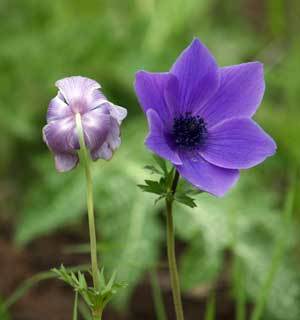Botanical Name:
Anemone
Life Cycle:
perennial bulb
Planting Time:
most species are planted in the fall
Height:
varies according to species
Exposure:
full sun or light shade
Soil:
light, well-drained soil
Hardiness:
zones 4- 11, but varies according to type
Bloom Time:
spring
Flower:
variety of colors
Foliage:
green
Propagation:
bulbs
Suggested Use:
shrub borders, woodland plantings, rock gardens, beds and borders
Growing Hints:
Plant Greek Wind Flower bulbs in
zones 4-8 in the spring. They grow to a height of 4" to 6" and prefer rich, well-drained soil and sun to partial shade. Plant Poppy Anemone bulbs in
zones 8-11 in the spring. They grow to heights of 12" to 18" and prefer light sandy soil and full sun. Both species are attractive to mice and squirrels and can be protected by laying chicken wire over soil after planting.
Interesting Facts:
Blooms close at night and on cloudy days. The Greek Wind Flower takes its name form a story out of Greek Mythology. Adonis was wounded by Aphrodite's jealous ex-lover while out hunting. When Aphrodite found him, she sprinkled nectar on his wounds. As she carried his lifeless body out of the woods, Crimson Anemones sprang up where drops of the nectar and his blood dripped to the ground.
It is said then, that the wind which blow blossoms open, will soon afterwards blow the petal away. So it is called the Wind Flower, for that which brings its life forth, ends it.
